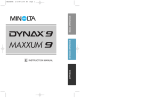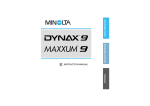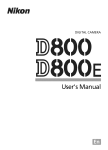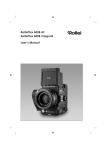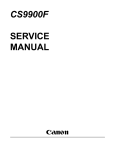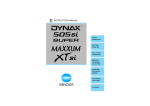Download Minolta DYNAX 9 Instruction manual
Transcript
Page 1 DETAILED OPERATION BASIC OPERATION 2/3/99 2:44 PM E INSTRUCTION MANUAL APPENDIX MAXXUM9E MAXXUM9E 2/3/99 2:44 PM Page 2 FOR PROPER AND SAFE USE The ultimate tool for creative professionals and advanced amateurs alike, the Maxxum / Dynax 9 has been designed with precission in mind to help you capture your photographic vision. As you use the Maxxum / Dynax 9, you will find that its performance and reliability compliment your own photographic expertise and in raising your skills to a higher level. In addition to its high durability zinc and stainless steel body, the Maxxum / Dynax 9 boasts the following features: • A top shutter speed of 1/12,000 sec. and top x-sync speed of 1/300 sec. • High speed autofocus with omni-dimensional Predictive Focus Control and a maximum framing rate of 4.5 frames/sec with autofocus tracking in continuous focus mode. (5.5 frames/sec in manual focus mode) • 100% viewfinder • 1/3 and 1/2 EV exposure compensation increments. • Data Memory storage of exposure information. • 21 Custom Functions to tailor the camera to your personal shooting style This manual has been designed to help you understand the operation of your camera and its functions. Please familiarize yourself with the names of the controls and their locations on the camera, then read the Getting Started and Basic Operation sections. Once you’ve mastered basic operation, move on to the Detailed Operation section to expand your expertise. This device complies with Part 15 of the FCC Rules. Operation is subject to the following two conditions: (1) This device may not cause harmful interference, and (2) this device must accept any interference received, including interference that may cause undesired operation. Changes or modifications not approved by the party responsible for compliance could void the user's authority to operate the equipment. This equipment has been tested and found to comply with the limits for a Class B digital device, pursuant to Part 15 of the FCC Rules. These limits are designed to provide reasonable protection against harmful interference in a residential installation. This equipment generates, uses and can radiate radio frequency energy and, if not installed and used in accordance with the instructions, may cause harmful interference to radio communications. However, there is no guarantee that interference will not occur in a particular installation. If this equipment does cause harmful interference to radio or television reception, which can be determined by turning the equipment off and on, the user is encouraged to try to correct the interference by one or more of the following measures: • Reorient or relocate the receiving antenna. • Increase the separation between the equipment and the receiver. • Connect the equipment to an outlet on a circuit different from that to which the receiver is connected. • Consult the dealer or an experienced radio/TV technician for help. Read and understand all warnings and cautions before using this product. WARNING Batteries may become hot or explode due to improper use. • • • • • • Use only the batteries specified in this instruction manual. Do not install the batteries with the polarity (+/–) reversed. Do not subject batteries to fire or high temperatures. Do not attempt to recharge, short, or disassemble. Do not mix batteries of different types, brands, or ages. Follow local regulations for battery disposal. Tape over lithium battery contacts before disposal. Use caution, accidents may occur when using this product near young children. Keep batteries and other things that could be swallowed away from young children. Contact a doctor immediately if an object is swallowed. Immediately remove the batteries and discontinue use if… • the camera is dropped or subjected to an impact in which the interior is exposed. • the camera emits a strange smell, heat, or smoke. Do not disassemble. Electric shock may occur if a high voltage circuit inside the camera is touched. Take your camera to a Minolta Service Facility when repairs are required. Do not look directly at the sun through the viewfinder. CAUTION Do not allow a camera lens to point directly at the sun. Fire may occur if sunlight comes to focus on a flammable surface. Replace the lens cap when the product is not being used. This mark on your camera certifies that this camera meets the requirements of the EU (European Union) concerning interference causing equipment regulations. CE stands for Conformité Européenne (European Conformity). This Class B digital apparatus complies with Canadian ICES-003. 1 MAXXUM9E 2/3/99 2:44 PM Page 2 TABLE OF CONTENTS Table of Contents ....................................2 Names of Parts .......................................4 GETTING STARTED Strap........................................................8 Diopter Adjustment .................................9 Batteries ................................................10 Lens.......................................................12 Handling the Camera ............................13 BASIC OPERATION Loading Film..........................................15 Taking Pictures in Full-Auto ..................18 Focus Signals ....................................19 Special Focus Situations.......................20 Focus Hold ............................................21 Using the Built-in Flash Operation ...........................................22 Flash Signals .....................................22 Flash Range ......................................23 Lens Shadowing ................................23 Rewinding the Film Automatic Rewind..............................24 Manual Rewind..................................24 FOCUS Predictive Focus Control .......................27 Autofocus Modes ..................................28 Wide Focus Area...................................30 Local Focus Area ..................................31 AF Lock .................................................32 Manual Focus........................................33 AF Illuminator ........................................34 EXPOSURE P-Mode..................................................36 A-Mode..................................................37 S-Mode..................................................39 M-Mode .................................................41 METERING Selectable Metering 14 Segment Metering ........................45 Spot Metering ....................................46 Center Weighted Metering.................47 AE Lock.................................................48 Exposure Compensation.......................50 Setting the ISO Manually ......................52 DRIVE Advance Mode ......................................54 Self Timer ..............................................56 Exposure Bracketing .............................58 Multiple Exposure..................................60 FLASH Four-Segment Flash Metering ..............63 Slow Sync .............................................64 Rear-Flash Sync ...................................65 High Speed Sync ..................................66 ADDITIONAL FEATURES Eye-Start ...............................................76 Depth-of Field Preview..........................77 Taking Time Exposures .........................78 Remote Release Terminal.....................80 PC Terminal...........................................81 Data Panel Illuminator...........................82 SPECIAL FUNCTIONS Data Memory Selecting ............................................84 Overwriting.........................................86 Recalling Data ...................................87 Deleting Stored Data .........................90 Accessory Information..........................104 Exposure Warnings ..............................106 Trouble Shooting ..................................108 Care and Storage.................................110 DETAILED OPERATION APPENDIX 2 Flash Compensation .............................67 Flash Bracketing ...................................68 Wireless/Remote Off-Camera Flash .....70 Custom Functions Setting................................................91 Details................................................92 Specifications .......................................112 3 MAXXUM9E 2/3/99 2:44 PM Page 4 NAMES OF PARTS For information on specific parts, refer to the page numbers shown in parenthesis. Diopter adjustment dial (9) Accessory shoe Body Built-in flash* (22-23) Drive-mode lever (54) AF Illuminator / Self-timer lamp (34, 56) Exposurecompensation dial lock (50) Exposurecompensation dial (50) Viewfinder* Exposure mode dial (36-43) Flash compensation dial (67) Dirve mode dial (54-61) Eyepiece shutter lever (79) Data Panel Flashcompensation dial lever (67) Main switch Shutter-release button Eyepiece cup Data-panel illuminator (82) Front control dial PC terminal (81) Film window Rear control dial Strap eyelet Eyepiece sensor* (76) Lens contacts* Remote-control terminal (80) AE-lock button (48) Grip sensor (76) Mounting index Mirror* Depth-of-field preview button (77) Lens mount (12) Lens release (12) Focus-mode switch (33) Back-cover release (15) AF mode dial (28) Eye-start switch (76) Metering-mode switch (45-47) AF button (32) Flash-mode switch Battery-chamber lock (10) Battery-chamber door (10) Vertical control grip contacts (104) * Do not touch 4 Tripod socket 5 MAXXUM9E 2/3/99 2:44 PM Page 6 NAMES OF PARTS Control Panel Viewfinder Data-memory button (84-90) Spot-focus area (95) Local focus areas (31) Manual-rewind button (24) Meter index (42) ISO button (52) Adjust button Control-panel door Focus frame Spot-metering area (46) Frames remaining counter (last 9 frames only) AE-lock indicator (48) Data Panel ISO mark Data memory indicator (84-90) Release priority indicator (92) Aperture display Shutter speed display (Focus area/ISO) Shutter speed display Focus signals (19) Aperture display (Exposure compensation /Bracketing) Battery condition indicator (11) Cartridge mark Frame counter Film transport signals Focus-area indicator Wireless/Remote flash indicator (70-74) Flash ready indicator (22) High-speed sync indicator (66) Flash on indicator (22) 6 7 MAXXUM9E 2/3/99 2:44 PM Page 8 Turn the diopter adjustment dial to compensate the eyepiece for near or far sighted vision problems. The adjustment range is from –3 to +1 diopters. GETTING STARTED Before attaching the lens… Look through the viewfinder at a well illuminated blank wall or clear blue sky. Turn the diopter-adjustment dial until the focus frame appears sharpest. Farsighted users – turn the dial clockwise. Nearsighted users – turn the dial counter-clockwise. Attaching the Strap Use the upper eyelets if you want the camera to hang horizontally. Use the side eyelets if you want the camera to hang vertically. If additional correction is needed, attach a Minolta Eyepiece Corrector (optional accessory) to the camera’s eyepiece. Attach the strap through the strap eyelets as shown. Pull firmly on the strap to make sure it is secure. 9 GETTING STARTED DIOPTER ADJUSTMENT MAXXUM9E 2/3/99 2:44 PM Page 10 Installing the Batteries Checking Battery Power Your camera uses two 3V CR123A lithium batteries to supply power for all camera operations. 1. Lift and turn the battery-chamber lock to OPEN, then open the batterychamber door. The battery condition indicator displays the power status of the batteries when the main switch is set to ON. Full-battery symbol Power is sufficient for all camera operations. Low-battery symbol 2. Insert the batteries as indicated by the + and – marks. Power is low, but all functions are operational. Keep a fresh battery handy. Blinking low-battery symbol Power is extremely low. The batteries will need to be replaced soon. Flash recycling time may be slow. 3. Close the battery-chamber door, then press and turn the batterychamber lock to CLOSE. Blinking low-battery symbol appears alone and the shutter locks. Power is insufficient for camera operation. Replace the batteries. No display Power is too low for the camera to operate. Replace the batteries or make sure they have been inserted correctly. 10 11 GETTING STARTED BATTERIES 2/3/99 2:44 PM Page 12 LENS HANDLING THE CAMERA Attaching the Lens Holding the Camera 1. Remove the body and rear lens caps. 2. Align the mounting indexes. 3. Insert the lens into the mount and turn it clockwise until it clicks into the locked position. • Do not press the lens release when mounting the lens. The lens will not couple properly. GETTING STARTED MAXXUM9E Grip the camera firmly with your right hand, while supporting the lens with your left. Keep your elbows at your side and your feet shoulder-width apart to hold the camera steady. Keep the camera strap around your neck or wrist in the event you accidentally drop the camera. • Do not touch the end of the lens barrel while taking a picture. • Do not block the AF illuminator. • Use a tripod when using slow shutter speeds or a telephoto lens. Pressing the Shutter-Release Button Press the shutter-release button partway down to activate the camera’s autofocus and auto-exposure systems. Removing the Lens 1. Press the lens release and turn the lens counter-clockwise until it stops. Gently press the shutter-release button all the way down to take the picture. 2. Remove the lens and replace the caps, or attach another lens. Caution • Do not force the lens if it does not turn smoothly. • Do not touch the inside of the camera, especially the lens contacts and mirror. 12 13 2/3/99 2:44 PM Page 14 LOADING FILM Check the film window before loading film. If film is loaded, do not open the back cover. Refer to Manual Rewind on page 24 to remove a partially exposed roll. • Load film in the shade to reduce the chances of fogging the film. • Do not use Polaroid Instant 35mm film. Winding problems may occur. Before loading film for the first time… Remove and discard the film gate protector. BASIC OPERATION 1. Turn the back-cover release counterclockwise to open the back cover. The shutter curtain’s precision design makes it extremely sensitive to pressure. Never touch it with your fingers or the film tip. Continued on the following page 15 BASIC OPERATION MAXXUM9E MAXXUM9E 2/3/99 2:44 PM Page 16 2. Insert a film cartridge into the film chamber. 4. Close the back cover and turn the main switch to ON. • The camera automatically advances the film to the first frame. 1 will appear in the frame counter. • The correct ISO for DX-coded film is set automatically. Refer to page 93 to reload a partially exposed roll. The ISO is displayed in the data panel for 5 seconds after loading. 3. Extend the leader between the guide rails to the index mark. • If the film tip extends beyond the index mark, push the excess film back into the cartridge. blinks in the frame counter and the shutter locks when the film is loaded incorrectly. Repeat steps 1 – 4. Non DX Coded Film Notes… Non-DX-coded film is automatically rewound at the end of the roll or after 36 exposures. Non-DX-coded film is set to the ISO from the previous roll. Refer to page 52 to set the film speed manually. 16 17 BASIC OPERATION LOADING FILM MAXXUM9E 2/3/99 2:44 PM Page 18 3. Center your subject in the focus frame, then press the shutter-release button partway down. 1. Turn the main switch to ON. • The local-focus area LED appears briefly indicating the focus area selected by the camera. 2. Set Full-Auto mode as shown. 4. When or appears in the viewfinder, press the shutterrelease button all the way down to take the picture. • The AF illuminator fires in low-light situations to assist the autofocus system (p.34). • Use focus hold (p.21) if your subject is outside the focus frame. • The number of frames remaining is displayed in the viewfinder for the last 9 frames on the roll. The countdown does not appear for non-DX coded film. Focus Signals The following signals appear in the viewfinder data panel to indicate the focus status when the shutter-release button is pressed partway down. Focus is confirmed. Set Set Set Set Set Set Set 18 the exposure mode dial to P. the drive mode dial to single frame advance (S). the metering-mode switch to . focus-mode switch to autofocus (AF). the AF-mode dial to automatic autofocus (A). the flash-compensation dial to 0. the exposure-compensation dial to 0. Continuous autofocus – Focus is confirmed. Continuous autofocus – Lens focusing. Shutter is locked. Focus cannot be confirmed – Shutter is locked. Subject is too close or is one of the special focus situations described on page 20. 19 BASIC OPERATION TAKING PICTURES IN FULL–AUTO 2/3/99 2:44 PM Page 20 SPECIAL FOCUS SITUATIONS The camera may not be able to focus in situations like those described below. When the focus signal blinks, use focus hold (p.21) or manual focus (p.33). See page 19 for an explanation of the focus signals. If the subject within the focus frame is very bright, or low in contrast. FOCUS HOLD Use focus hold when your subject is outside the focus frame or when autofocus is difficult to confirm. BASIC OPERATION MAXXUM9E • Use AF Lock (p. 32) to lock focus on moving subjects. • Focus hold does not operate when continuous autofocus mode (p.29) is selected. Use AF Lock. Focus hold cannot be used for moving subjects. 1. Center your subject in the focus frame, then press the shutter-release button partway down. If two subjects at different distances overlap in the focus frame. If a subject composed of alternating light and dark lines completely fills the focus frame. If your subject is near a very bright object or area. 20 • appears in the viewfinder when focus is confirmed. • Focus hold also locks the exposure settings when 14 segment metering is selected (p. 45). 2. Continue to hold the shutter-release button partway down while you compose your picture. 3. Press the shutter-release button the rest of the way down to take the picture. • Remove your finger from the shutter-release button to cancel focus hold. 21 MAXXUM9E 2/3/99 2:44 PM Page 22 USING THE BUILT-IN FLASH When up, the built-in flash fires every time the shutter is released to provide coverage for focal lengths as wide as 24mm. Flash output is automatically controlled by the camera’s TTL flash metering system. • . will appear in the viewfinder data panel. Slide the flash-mode switch to to reduce the redeye effect when using the built-in flash. • Red-eye reduction mode is only available with the built-in flash. 2. Grip both sides of the flash and lift. appears in the viewfinder when the flash is fully charged. • The shutter can not be released until the flash is charged. The range of the built-in flash depends on the speed of the film and the selected aperture. Make sure your subject is within the flash range specified in the table below. Make sure you are at least 1m (3.3 ft.) from your subject when using the built-in flash. Aperture f/2.8 f/3.5 f/4 • - Push the flash down to turn it off. Flash Signals The following signals appear in the viewfinder data panel to indicate the flash status when the shutter-release button is pressed partway down. Flash will fire when the shutter is released. Flash is charged. BASIC OPERATION 1. Slide the flash mode switch to Flash Range f/5.6 ISO 100 ISO 200 ISO 400 1.0 ~ 4.3m (3.3 ~ 14.1 ft.) 1.0 ~ 3.4m (3.3 ~ 11.2 ft.) 1.0 ~ 3.0m (3.3 ~ 9.8 ft.) 1.0 ~ 2.1m (3.3 ~ 6.9 ft.) 1.0 ~ 6.1m (3.3 ~ 20.0 ft.) 1.0 ~ 4.8m (3.3 ~ 15.7 ft.) 1.0 ~ 4.2m (3.3 ~ 13.8 ft.) 1.0 ~ 3.0m (3.3 ~ 9.8 ft.) 1.0 ~ 8.6m (3.3 ~ 28.2 ft.) 1.0 ~ 6.8m (3.3 ~ 22.3 ft.) 1.0 ~ 6.m (3.3 ~ 19.7 ft.) 1.0 ~ 4.3m (3.3 ~ 14.1 ft.) Lens Shadowing Lens shadowing occurs when the lens or lens hood blocks part of the output from the built-in flash. Lens shadowing appears as semi-circular shaded area at the bottom (horizontal) or side (vertical) of your image. • Remove the lens hood before using the built-in flash. • Lens shadowing may occur with the following lenses at shorter focal lengths. AF Zoom 17-35mm f/3.5G AF Zoom 28-70mm f/2.8G AF Zoom 28-85mm f/3.5-4.5 AF Zoom 28-135mm f/4-4.5 • The built-in flash can not be used with the following lenses: AF 300mm f/2.8 (APO tele) AF 600mm f/4 (APO tele) Previous exposure was correct. 22 23 MAXXUM9E 2/3/99 2:44 PM Page 24 REWINDING THE FILM Automatic Rewind The film is automatically rewound after the last frame is exposed (or 36 exposures). When the film is completely rewound, the motor will stop and will blink in the data panel indicating it is safe to open the back of the camera. 1. Wait until the film is completely rewound. will appear and will blink in the data panel. 2. Open the back cover and remove the film. 3. Close the back cover. Manual Rewind Use manual rewind to rewind the film before the current roll is finished. 1. Open the control panel door, then press the manual-rewind button. 2. Follow steps 1-3 from Automatic Rewind. Custom Function Notes Automatic (1) or manually initiated (2) rewind (p.92). Rewind the leader into the cartridge (1) or leave the leader out (2) (p.92). Fast or slow/silent rewind (p.97). 24 DETAILED OPERATION DETAILED OPERATION • 2/3/99 2:45 PM Page 26 FOCUS - Predictive Focus Control Predictive Focus Control determines the subject’s speed, position, and acceleration changes from the focus sensor data, then sets the best focus at the predicted point of exposure. Predictive focus control is always active in the Automatic and Continuous autofocus modes. FOCUS With the ability to track acceleration in all three dimensions, Predictive Focus Control makes it possible for the camera to calculate where your subject will be when the shutter opens. FOCUS MAXXUM9E 27 MAXXUM9E 2/3/99 2:45 PM Page 28 FOCUS — Autofocus Modes Selecting the Autofocus Mode 1. Set the focus mode switch to AF. 2. Turn the AF mode dial to the desired mode. Continuous Autofocus (C) Use Continuous Autofocus when shooting sporting events or when you know the subject will be in constant motion. Center your subject in the focus frame, then press the shutter-release button partway down to activate autofocus. The camera continues to focus as long as the shutter-release button is pressed partway down. Automatic Autofocus (A) Designed to work well in almost any situation, Automatic Autofocus is especially suited to moving subjects that stop suddenly. Center your subject in the focus frame, then press the shutter-release button partway down to activate autofocus. The camera will continue focusing while the subject is moving, then lock focus when the subject is still. 28 FOCUS • The AF Illuminator (p.34) does not operate in Continuous Autofocus mode. • The focus area is not displayed unless the AF button is pressed. Single Shot Autofocus (S) Use Single-shot AF when photographing non-moving subjects or to lock focus on subjects outside the focus area. Center your subject in the focus frame, then press the shutter-release button partway down to activate autofocus. Once confirmed, focus remains locked until pressure is removed from the shutter-release button or the shutter is released. 29 MAXXUM9E 2/3/99 2:45 PM Page 30 FOCUS — Focus Area Wide Focus Area Local Focus Area The camera’s standard focus mode, wide focus area uses the camera’s three focus sensors to automatically focus on your subject. Wide focus area’s greater framing flexibility makes it easier for the camera to focus on moving subjects. • Select a local focus area for greater control over the focus location in the autofocus mode. • Only the center focus area can be selected when the RF 500mm or the AF Power Zoom 35-80mm is mounted. 1. Press the AF button and turn the front control dial to select the desired local focus area. appears in the viewfinder data panel when wide focus area is selected. • The local focus area is displayed in the focus frame and data panels. FOCUS The camera determines which sensor is focusing on your subject and sets the focus accordingly. 2. Release the AF button when the desired local focus area appears. The selected focus area momentarily appears in the viewfinder frame when the shutter release button is pressed partway down. • The focus-area indicator displays the currently selected focus area. • The focus area LEDs do not appear when continuous autofocus (p.29) is selected. Custom Function Notes Wide / Local Focus Area (1) or Spot Focus (2) when the AF button is pressed (p.96). 30 31 MAXXUM9E 2/3/99 2:45 PM Page 32 FOCUS — AF Lock FOCUS — Manual Focus Press the AF button to lock focus on moving or stationary subjects using the current focus mode. The focus remains locked until the AF button is released. • Exposure is also locked if 14-segment metering (p.45) is selected. • Pressing the AF button also activates the AF illuminator. 1. Center your subject in the focus frame. Focus the lens manually when autofocus is not suitable and focus hold is not possible. The autofocus system will monitor focus and indicate when a subject in the focus frame is in focus. • Only the center weighted average (p. 47) and spot (p. 46) metering modes are available in manual focus mode. • 14-segment honeycomb pattern metering (p. 45) is changed to center weighted average metering when manual focus mode is selected. 1. Slide the focus-mode switch to M. • The current local focus area LED appears in the viewfinder data panel until the AF button is released. • The exposure settings do not appear until the shutter-release button is pressed partway down. 2. Turn the focusing ring until your subject appears sharp and focused. • appears in the viewfinder when the subject in the focus frame is in focus. Turn the front control dial to select a different local focus area. 3. Recompose the scene as desired, then take the picture. AF Power Zoom and xi-Series Lenses Pull and turn the zoom ring until your subject appears sharp. 32 33 FOCUS 2. Press and hold the AF button. MAXXUM9E 2/3/99 2:45 PM Page 34 FOCUS — AF Illuminator In low-light / low subject contrast situations, the AF illuminator automatically projects a pattern of lines onto the subject for the camera’s AF sensors to focus on. 34 Do not to obstruct the AF illuminator. Pressing the AF button (p.32) also activates the AF illuminator. The range of the AF Illuminator is 0.7 – 7.0 meters (2.3 – 23.0 ft.). The AF illuminator will not fire in continuous autofocus mode. The AF illuminator may not operate with 300mm or longer single focal length lenses. The AF illuminator will not operate with 3x-1x Macro Zoom. When an accessory flash is attached, its AF illuminator may be active in place of the camera’s AF illuminator. EXPOSURE EXPOSURE • • • • • • • MAXXUM9E 2/3/99 2:45 PM Page 36 EXPOSURE — P-Mode Select P-mode (Programmed Autoexposure) when you want to give your full attention to your subject and composition. The Program mode software analizes the subject’s size, motion, and magnification as well as the focal length of your lens, then sets the shutter speed and aperture according to the requirements of the scene. 1. Set the exposure-mode dial to P. EXPOSURE — A-Mode In A-mode (Aperture Priority), you select the aperture and the camera automatically sets the shutter speed required for proper exposure. Set the camera to A-mode when you want to control the range of focus (depth-of-field) in an image. Press the depth of field button to confirm the range of focus in your image (p.77). 2. Compose your scene, focus, and take the picture. 2. Turn either control dial to select the aperture. P-Mode Flash • The aperture setting changes in 1/2 or 1/3 EV increments depending on the position of the exposure compensation dial. See page 51. When the built-in flash is up or an attached accessory flash is on, it will fire each time the shutter is released. The camera’s TTL automatic flash metering system will ensure proper exposure. • Make sure your subject is within the flash range (p.23). Custom Function Notes Setting 2 - PA/Ps mode (p.101). This mode lets you override the exposure settings selected by the camera in P mode. 36 If 12000 or 30” blinks in the viewfinder and the data panel, the required setting is beyond the camera’s shutter speed range. Turn the control dial until the blinking stops. 37 EXPOSURE 1. Turn the exposure-mode dial to A. MAXXUM9E 2/3/99 2:45 PM Page 38 EXPOSURE — S-Mode EXPOSURE — A-Mode A-mode flash When the built-in flash is up or an attached accessory flash is on, it will fire each time the shutter is released. The camera’s TTL automatic flash metering system will ensure proper exposure. In S-mode (Shutter Priority), the camera automatically sets the aperture for the selected shutter speed. Use S-mode when you want to control the blur caused by subject movement. 1. Turn the exposure-mode dial to S. 1. Raise the built-in flash. • appears in the viewfinder when the flash is charged. • The shutter speed is automatically set to 1/300 or slower. 2. Turn either control dial to select the shutter speed. • The shutter speed changes in 1/2 or 1/3 EV increments depending on the position of the exposure compensation dial. See page 51. EXPOSURE 2. Turn the control dial to select the aperture. • Refer to the Flash Range table on page 23 to determine the range of the built-in flash at the selected aperture. If 300 blinks in the viewfinder and the data panel, the light level is too bright for the selected aperture. Turn the control dial until the blinking stops or cancel the flash. If the aperture display in the viewfinder and the data panel blinks, the required setting is outside the aperture range of the lens. Turn the control dial until the blinking stops. Push the built-in flash down or turn the accessory flash off to cancel the flash. 38 39 MAXXUM9E 2/3/99 2:45 PM Page 40 EXPOSURE — M-Mode EXPOSURE — S-Mode S-mode Flash When the built-in flash is up or an attached accessory flash is on, it will fire each time a picture is taken. Flash exposure is controlled by the camera’s TTL automatic flash metering system. M-mode gives you full control of the exposure. The camera’s meter index displays how your settings compare to the exposure determined by the camera’s metering system. • The aperture and shutter speed settings change in 1/2 or 1/3 EV increments depending on the current exposure compensation dial setting. 1. Raise the built-in flash. • 1. Turn the exposure-mode dial to M. appears in the viewfinder when the flash is charged. 2. Turn the front control dial to select the shutter speed. 3. Turn the rear control dial to select the aperture. EXPOSURE 2. Turn the control dial to select any shutter speed up to 1/300th of a second. • The camera sets the required aperture automatically. Manual Shift Manual shift lets you shift to equivalent aperture/shutter speed combinations without changing the exposure value (EV). Push the built-in flash down or turn the accessory flash off to cancel the flash. 40 Press the AE-lock button and turn the front control dial until the desired aperture / shutter speed combination appears in the data panel. 41 MAXXUM9E 2/3/99 2:45 PM Page 42 EXPOSURE — M-Mode Metering in Manual Mode The meter index displays the EV difference between your settings and the ‘correct’ exposure determined by the camera. The 0 position (null point) represents the recommended exposure using the currently selected metering pattern (pp.45-47). • The EV scale is marked in 1/2 or 1/3EV increments depending on the current setting of the exposure compensation dial (p.51). • A second indicator will appear in the meter index to indicate the new null point if the exposure compensation dial is set to a value other than 0. M-mode Flash When the built-in flash is up or an attached accessory flash is on, it will fire each time the shutter is released. The camera’s TTL flash metering system will ensure correct exposure. 1. Raise the built-in flash. • appears in the viewfinder when the flash is charged. Your settings will overexpose the metered area by 1EV. Your settings will underexpose the metered area by 1.5EV. 2. Turn the front control dial to select any shutter speed up to 1/300th of a second. 3. Turn the rear control dial to select the desired aperture. • Refer to the flash range table on page 23 to determine the range of the built-in flash at the selected aperture. or will blink in the meter index if the settings will over or underexpose the subject by more than 3.0EV. 42 43 EXPOSURE Your settings match the recommended exposure. 2/3/99 2:45 PM Page 44 METERING — Selectable Metering 14 Segment Honeycomb Pattern Metering Fourteen-Segment Honeycomb-Pattern Metering uses information from the autofocus system to set the metering pattern according to the position of the main subject. The light metered by each applicable segment is then evaluated to determine the degree of spot-lighting or backlighting present in your scene. The local focus-area (LED) momentarily displays the sensor being used when the shutter release button is pressed partway down. Fourteen-Segment Honeycomb-Pattern Metering is the camera’s standard metering mode and is appropriate for most photographic situations. METERING Selecting 14 Segment Honeycomb Pattern Metering Turn the metering mode switch to . METERING MAXXUM9E 45 MAXXUM9E 2/3/99 2:45 PM Page 46 METERING — Selectable Metering Spot Metering Center Weighted Average Metering Spot metering uses only the center honeycomb segment to meter the image. • The spot-metering area indicates the metering area. Selecting Spot Metering Center-weighted average mode bases the exposure on an average of the readings from each of the honeycomb segments - with emphasis placed on the center of the image. Care should be taken when photographing backlit, spotlit, or off-center subjects as non-subject areas may be included in the exposure calculation. Selecting Center Weighted Average Metering Turn the metering mode switch to . . METERING Turn the metering mode switch to 46 47 MAXXUM9E 2/3/99 2:45 PM Page 48 METERING — Automatic Exposure Lock (AEL) Press the AE-lock button to lock the exposure using the currently selected metering pattern without locking the focus. The exposure remains locked until the AE-lock button is released. 4. Recompose the scene as desired. • The meter index indicators display the EV difference between the locked exposure and the exposure for the subject area currently inside the spot metering area. • Pressing the AE-lock button sets the flash to slow sync mode (p.64). • The second indicator in the exposure index does not appear when slow sync is selected. Current Reading 1. Select the desired metering pattern (pp.45-47). 2. Meter the area on which you want to lock the exposure. 5. Press the shutter-release button allthe-way down to take the picture. Custom Function Notes 3. Press and hold the AE-lock button. • AEL appears in the viewfinder. 48 Setting 2. Press the AE-lock button once to activate Automatic Exposure Lock. Press again to cancel. 49 METERING Locked Exposure (0) MAXXUM9E 2/3/99 2:45 PM Page 50 METERING – Exposure Compensation Especially helpful when using the spot or center weighted metering patterns, exposure compensation lets you manually adjust the metered exposure +/– 3 EVs in 1/2 or +/– 2 EVs in 1/3 EV increments. Changing to 1/3 EV Increments 1. Set the exposure compensation dial to +/– 0 EV. 2. Pull the exposure-compensation dial up, then rotate it 180°. • The camera may be damaged if the exposure compensation dial is not set to 0 EV before pulling it up. Compensated Exposure More exposure is recommended when the scene is primarily white tones. Less exposure is recommended when the scene is composed of darker tones or shadows. The effect is most visible when slide film is being used. 1. Unlock the exposure compensation dial. Exposure compensation dial lock 3. Set the exposure compensation dial down at 0 on the 1/3 EV increment side. METERING Metered Exposure • The exposure may be incorrect if the exposure compensation dial is not seated properly. • The meter index scale changes to 1/3EV increments. • Shutter speed and aperture will change in 1/3 EV increments. 4. Set the desired compensation value. Custom Function Notes Select setting 3 to change the exposure compensation value using the rear control dial in A, S, and P modes. 2. Rotate the exposure compensation dial to the desired compensation value. • The compensation value is indicated in the meter index. 50 • A +/– 3 EV range is available for 1/3 EV increments in this setting. Select setting 2 to view the exposure compensation value in the data panel when the exposure compensation dial is set to a value other than 0. 51 MAXXUM9E 2/3/99 2:45 PM Page 52 METERING — Setting the ISO Manually Set the ISO manually to override the DX-coded ISO or when using non-DX coded film. • Non-DX coded film is initially set to the previous roll’s ISO. Film must be loaded before the ISO can be changed. 1. Open the control panel door and press the ISO button. 2. Turn either control dial to set the desired ISO value. • The ISO can be changed manually from 6 to 6400 in 1/3 EV increments. 3. Press the shutter-release button partway down to enter the new ISO. Custom Function Notes Setting 2 - DX Memory On (p.94). Applies ISO changes to future rolls with the same DX-coded ISO. 52 DRIVE DRIVE MAXXUM9E 2/3/99 2:45 PM Page 54 DRIVE – Advance Mode This camera has both single frame and continuous advance drive modes. Select single frame advance to expose and advance the film one frame at a time. Switch to continuous drive to photograph dynamic action sequences at up to 5.5 frames per second (4.5 frames per second in autofocus mode). 2. Turn either control dial to select or speed continuous drive. • AF Zoom xi and Power zoom lenses cannot be zoomed when continuous-advance mode is selected. • The shutter can not be released until the camera has focused on your subject. • The maximum drive speed changes depending on the focus mode. • When the built-in flash is up or an accessory flash is on, the shutter can not be released until the flash is charged. Turn the drive-mode lever to the desired drive mode. S – Single Frame Advance C – Continuous Advance 3. Press the shutter-release button partway down to enter the selection. If continuous advance is selected… 1. Open the control panel door, then press the adjust button. HI Lo Single Shot AF (S) 5.5 fps 2 fps Automatic AF (A) 4.5 fps 2 fps Continuous AF (C) 4.5 fps 2 fps Manual Focus (M) 5.5 fps 2 fps DRIVE Maximum Framing Rate Focus Mode • The maximum drive speed drops to 5 frames per second when Data Memory is activated. • At drive speeds faster than 5 frames per second, the optional Quartz Data Back QD-9 will imprint the date or time only on the first frame of a motor advanced series. • The maximum drive speed is 4.5 fps when the Data Memory Back DM-9’s imprinting function is activated. Custom Function Notes Switch to setting 2 for release priority operation (p.92). • RP will appear in the data panel. 54 55 MAXXUM9E 2/3/99 2:45 PM Page 56 DRIVE – Self-Timer Use the self-timer to delay the shutter release for 2 or 10 seconds (approx.) after the shutter-release button is pressed all the way down. In addition to delaying release of the shutter, the 2 second delay pops the mirror up two seconds before the shutter opens to reduce blur caused by camera vibration. • The red-eye reduction flash mode is not effective when the 2 second self timer is selected. • Close the eyepiece shutter (p.79) to prevent a bright light source behind the camera from interfering with the exposure. 1. Place the camera on a tripod, then turn the drive-mode lever to . 5. Center your subject in the focus frame, then press the shutterrelease button part way down to confirm the focus. • The shutter will be released even if the focus is not confirmed. 6. Press the shutter-release button all the way down to start the timer. • Turn the main switch to LOCK or select another drive mode to cancel the 10 sec self timer. (2 sec) – 2. Open the control panel door and press the adjust button. The mirror pops up when the shutter release button is pressed all-the-way down. The shutter is released two seconds later. • The 2 second self timer cannot be cancelled. 3. Turn either control dial until the desired delay appears in the data panel. 4. Press the shutter-release button partway down to enter the selection. 56 57 DRIVE (10 sec) – The self-timer indicator on the front of the camera will blink slowly, then blink rapidly just before the shutter releases.






























